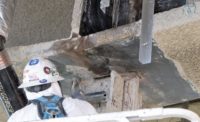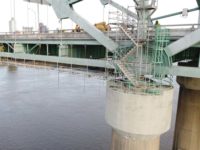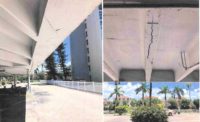The American Concrete Institute is gearing up to develop ACI’s first code requirements specifically for precast concrete. The recent announcement of the initiative comes on the heels of an article in the September issue of ACI’s monthly magazine, Concrete International, that sounds the alarm about the potential for brittle failures of precast, prestressed-concrete double-T parking decks, with flanges reinforced with a non-code-compliant polymer-coated carbon-fiber grid product, called C-Grid.
“Brittle Failures in Precast Parking Structures,” by William L. Gamble, Gordon H. Reigstad and Jason Reigstad, alleges collapses of precast double-T flanges, containing C-Grid, are attributable to “design and fabrication flaws.”
To date, there have been no serious injuries caused by the flange failures. And C-Grid for precast has been off the market for several years, says Jason Reigstad, vice president of structural engineer Reigstad & Associates Inc., formed by his father, Gordon, 40 years ago.
Public Safety Issue
Jason, who estimates there are at least 100 garages with similar underdesigned decks, maintains it is simply a matter of time until someone is killed. “This is a public safety issue,” says Reigstad, a 2017 ENR Top 25 Newsmaker, for bringing to light the potential dangers of the carbon-fiber-reinforced polymer (CFRP) precast decks (ENR 1/22/18 p. 35).
The decision to write a consensus standard specifically for precast and the article on the flange failures of the non-code-compliant precast are not related, says Ron Burg, ACI’s executive vice president. Rather, the standard effort is in response to interest expressed by “a number of people in the precast [sector] and on the ACI 318 committee,” which writes the bible for the design of concrete structures: ACI 318: Building Code Requirements for Structural Concrete.
Concrete International’s editor-in-chief, Rex Donahey, could not be reached for comment. But an editor’s note, with the article, says, “Views expressed are solely those of the authors and do not necessarily represent the opinion of ACI.”
The article was inspired by ramp failures at Harrah’s Cherokee Casino and Hotel in Cherokee, N.C., and at the California, Pa., campus of California University, part of the state university system.
Reigstad was the engineer-of-record for the overall Harrah’s Cherokee development (ENR 4/10/17 p. 10). But Reigstad did not engineer the garage decks.
Ongoing Investigation
The Reigstads and Gamble, professor emeritus of civil and environmental engineering at the University of Illinois at Urbana-Champaign, have provided forensic legal support for Harrah’s owner, the Tribal Casino Gaming Enterprise (TCGE) of the Eastern Band of the Cherokee Indians, in disputes with Harrah’s garage contractors. And all three authors are involved in an ongoing investigation of similar C-Grid structures.
The first known brittle failure occurred on Feb. 19, 2015. It involved a ramp in the hotel’s 1,200-space garage, finished in 2009. The second, on April 15, 2016, involved a ramp in the casino’s 2,400-space garage, finished in 2010.
Reigstad investigated the failures, evaluated the structures and designed the repairs, which involved adding stainless steel deformed bars to reinforce the flanges. The fiber-reinforced polymer reinforcing was underdesigned by “nearly a factor of four,” says Jason Reigstad.
The article’s authors call for precast producers to alert customers about the potential design issues regarding CFRP parking decks and to initiate appropriate remediation. They also call for code updates to require that slab reinforcement is sufficient “to ensure that the nominal moment capacity exceeds the cracking capacity.”
Beyond that, the authors would like the building code changed to mandate that sponsors of any alternative system, not in the code, “shall present the data on which their design is based to the building official or to a board of examiners appointed by the building official.”
The article states that “construction documents and inspections of failed flanges show that the failed areas contain only concrete, steel embedments placed along the flange edges…and the grid product.” Further, “because the grid reinforcement has been shown to provide no increase in bending capacity over the cracking moment, flanges containing the grid are essentially plain concrete members,” continues the article.
Repaired Structures
Hotel garage repairs were completed in the summer of 2016 and casino garage repairs in 2017. The repaired structures are functioning as intended, says Reigstad.
In early 2016, TCGE filed a claim against the contractor W.G. Yates & Sons Construction Co. and Metromont Corp., which supplied the CarbonCast double-Ts reinforced with C-Grid. In an April 2018 judgment, the U.S. District Court for the Western District of North Carolina confirmed an arbitration award for the casino deck and entered a judgment against Metromont in the principal amount of $3.7 million, minus $150,000 already received from Yates, with interest. The total judgment was $4,199,528.76.
Metromont had by then paid in full, says Aaron Lay, a partner in TCGE’s law firm, Hamilton Stephens Steele + Martin PLLC. He adds that the arbitration panel had dismissed the hotel deck complaint, saying the state’s six-year statute of repose applied to the older deck. The statute of limitations and repose is a “real danger,” because most of the decks were built from 2008 to 2015, says Lay.
Repeated Overloading
In response, Richard H. Pennell Jr, Metromont's president and CEO, says the failures at the Cherokee garages were caused by repeated overloading of the double-Ts over a period of years. Records from local wrecker companies showed that overweight tow vehicles entered and transited the parking structures, on average, three to five days, he says, in an Oct. 11 letter to ENR.
"The only fault found by the arbitration panel on the part of our company was a failure to clearly disclose the design limitations implicit in the design criteria specified by Reigstad & Associates itself," says Pennell.
The panel also found that the owner ignored subsequent warnings about overweight vehicles, even those [warnings] delivered by the Reigstads, given years before the failures, he says.
"The real story of the Cherokee garages is that persistent and pervasive overloading beyond specified design criteria can eventually lead to failure," Pennell continues. "Similar failures have occurred in double-Ts reinforced with welded wire fabric."
Details about the status of a current dispute regarding the California University garage are not available. But a complaint filed in the Court of Common Pleas of Washington County, Pennsylvania, says defendant Manheim Corp. supplied the garage under a $10.48-million design-build contract, using structural precast concrete double-Ts, reinforced with C-Grid, for decks and ramps.
The complaint alleges metal structural concrete reinforcement was specified in the school’s request for proposal. The school is suing for breach of contract.
Failed Precast
Manheim reached substantial completion of the garage on Aug. 23, 2010. On Aug. 26, 2016, a 20-ft x 2-ft concrete slab crashed to the ground level from the second level, nearly hitting two people and crushing several parked cars, claims the complaint. Inspection revealed many cracked and failed precast concrete double-Ts, the complaint says. The garage remains closed—unrepaired.
The school has a policy of not commenting on ongoing litigation. Manheim could not be reached for comment.
There are problems at other C-Grid garages. The Office of the Attorney General of Virginia is investigating state-owned decks. Central Piedmont Community College, Charlotte, N.C., closed a C-Grid garage and is doing preventive repairs. Another garage, owned by Charlotte Area Transit, is also troubled.
More Standards Coming
According to Pennell, the PCI Design Manual, in its eighth edition has long been "the leading" industry resource for the design, manufacture and use of structural precast, prestressed concrete and architectural precast concrete. And there are other precast standards coming. The International Building Code has approved certain standards for adoption in its next edition due in 2021, says Pennell.
Concurrent with ACI, the Prestressed/Precast Concrete Institute is writing a standard, which has been in process for more than a year, and expects to collaborate with ACI committees in this process, adds Pennell.
Andrea Schokkar, professor and head of civil engineering at the University of Minnesota, Duluth, chairs the new ACI Committee 319, Precast Structural Concrete Code. The committee’s first in-person meeting is Oct. 21, at ACI’s Fall Convention in Cincinnati.
It is too early for any details about the standard, including the development timeline and content, but Burg says it is needed because ACI 318 does not totally address certain detailing and design issues related to precast. After precast requirements, ACI plans to develop a specific standard for post-tensioned concrete.
This article was revised on Friday, Oct. 11, to reflect additional information from Metromont Corp.






Post a comment to this article
Report Abusive Comment